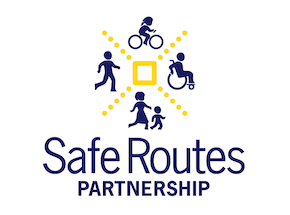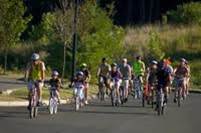 At the National Bike Summit this year, Douglas Meyer from Bernuth & Williamson presented some fascinating results about what Congressional allies and opponents think about bicycling.
At the National Bike Summit this year, Douglas Meyer from Bernuth & Williamson presented some fascinating results about what Congressional allies and opponents think about bicycling.
Resource Library
This fact sheet provides highlights from the 2009 National Household Travel Survey released in 2010.
School districts that adopt school bicycling or walking policies ensure that transportation safety rules for the district are consistent and standardized. Policies developed at this jurisdictional level can also help lay the groundwork for better and safer behaviors. This document provides a model school bicycling policy.
 Spring brings a new season for the State Network Project in New Jersey. As you have likely heard, I will be leaving the Safe Routes Partnership this month. But like I welcome the warmer and longer days, I also look forward to new opportunities and stronger partnerships. I am moving onto a program at Montclair State University that still has ties to the SRTS movement.
Spring brings a new season for the State Network Project in New Jersey. As you have likely heard, I will be leaving the Safe Routes Partnership this month. But like I welcome the warmer and longer days, I also look forward to new opportunities and stronger partnerships. I am moving onto a program at Montclair State University that still has ties to the SRTS movement.
This report indicates how Safe Routes to School is reducing carbon emissions and air pollutants.
 Last week, the Southern California Association of Governments (SCAG) convened the annual Regional Conference and General Assembly (GA) in Palm Desert for two days. The GA is a yearly convening of elected officials from across Southern California to celebrate the accomplishments of the past year.
Last week, the Southern California Association of Governments (SCAG) convened the annual Regional Conference and General Assembly (GA) in Palm Desert for two days. The GA is a yearly convening of elected officials from across Southern California to celebrate the accomplishments of the past year.
 A new study from U.S. PIRG and the Frontier Group shows that after decades of steady growth, U.S. driving rates have slowed, and even stalled – and that in the long term, Americans are unlikely to return to driving as much as they did before.
A new study from U.S. PIRG and the Frontier Group shows that after decades of steady growth, U.S. driving rates have slowed, and even stalled – and that in the long term, Americans are unlikely to return to driving as much as they did before.
The U.S. GAO report on Safe Routes to School was released on July 31, 2008.

In May 2007, the Safe Routes Partnership launched a three-year Safe Routes to School (SRTS) State Network Project to leverage resources in nine states and the District of Columbia.
 It’s hard to believe that it has been more than a year since Congress passed the transportation bill, MAP-21, which consolidated Safe Routes to School into the Transportation Alternatives program (TAP).
It’s hard to believe that it has been more than a year since Congress passed the transportation bill, MAP-21, which consolidated Safe Routes to School into the Transportation Alternatives program (TAP).
This guide is intended to help demystify regional transportation plans (RTPs), explain key components and requirements, identify ways to incorporate health‐promoting strategies into RTPs, and showcase short case studies of improving community health through RTPs.
As the incidence of pediatric obesity and sedentary lifestyle increases, more children are being diagnosed with Type 2 diabetes, formerly a chronic disease primarily of adults who were overweight and had a sedentary lifestyle.

Safe Routes to School (SRTS) programs can help reduce schools’ risk of liability while making it safer for students to walk or bike. This fact sheet explains why liability fears shouldn’t keep schools from supporting SRTS programs, and offers practical tips for schools and community advocates.
 In my last post, I talked about the government shutdown and how the fighting over funding could be a bad sign for the next surface transportation bill, given the $15 billion per year funding shortfall.
In my last post, I talked about the government shutdown and how the fighting over funding could be a bad sign for the next surface transportation bill, given the $15 billion per year funding shortfall.
This collection of design and engineering tactics is not intended to be comprehensive, but rather highlight the innovative, nonmandatory tactics that accommodate or encourage walking, safety elements, and signal treatments.
Based on an interview with principal Anne Lintner and home-school liaison Sonny Rodriguez of Keister Elementary School in Harrisonburg, VA.
Encouragement is one of the complementary strategies that Safe Routes to School (SRTS) programs use to increase the number of children who walk and bicycle to school safely. In particular, encouragement and education strategies are closely intertwined, working together to promote walking and bicycling.


